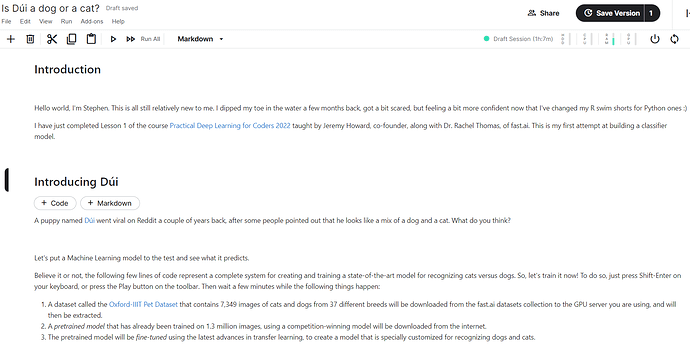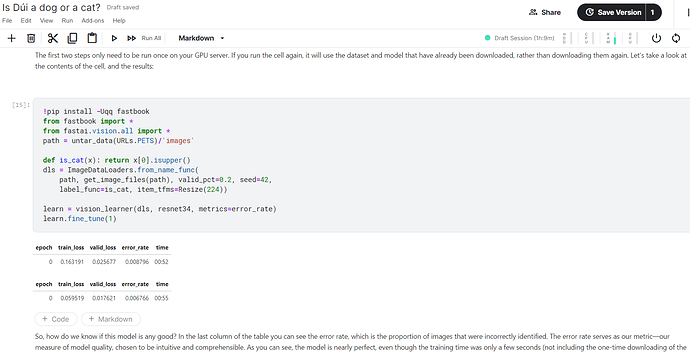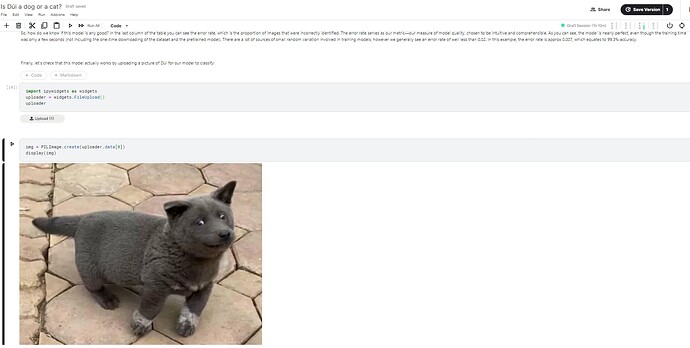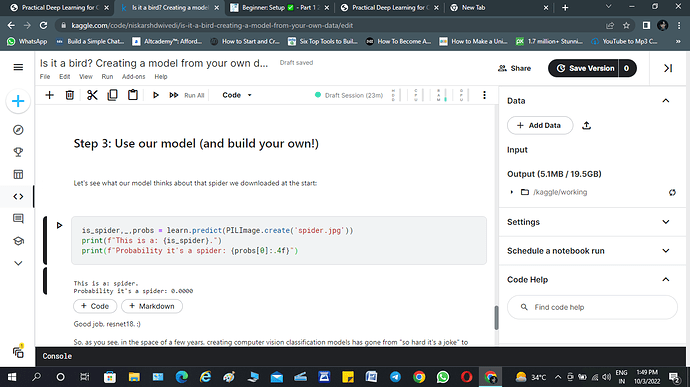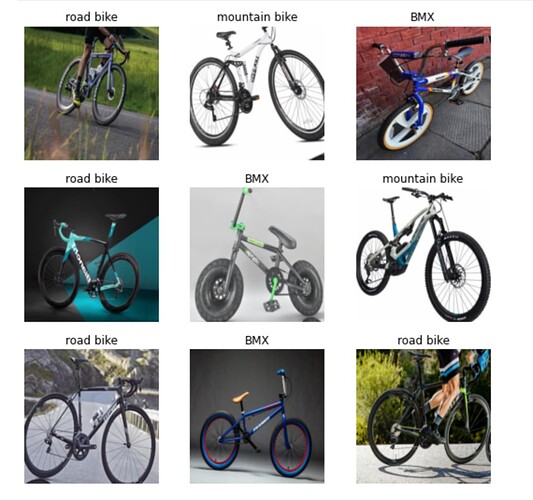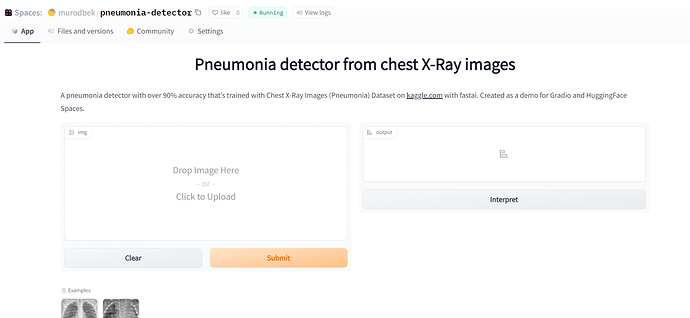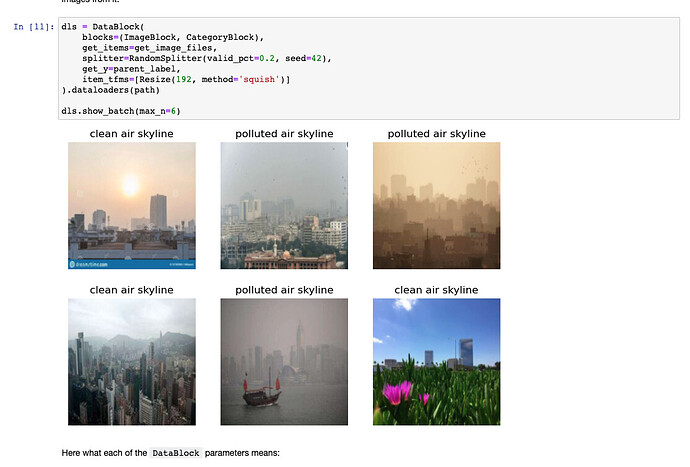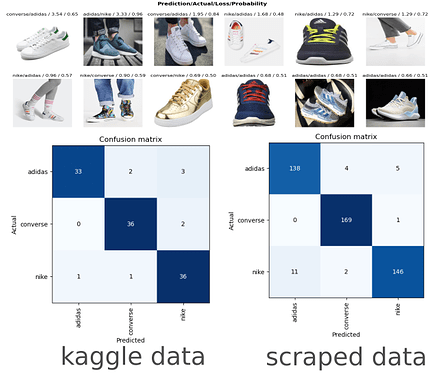I like your blog. How did you create it ? I also want to blog about my project.
Hello world, this is all very new to me.
I’m a chartered accountant by trade, with a maths & statistics background, looking to transition into Data Science, and Machine Learning in particular.
My first tentative step was the Google Data Analytics certificate, which gave me an introduction to R, SQL and Tableau. I quickly followed this up with some Python courses via DataCamp and was in the middle of the Machine Learning Specialization taught by Andrew Ng until just a couple of days ago, when I had the fortune to stumble upon this course!
I have been caught in the trap of the traditional model of learning (as alluded to by Jeremy) and find this hands on approach very refreshing!
Anyway, I started off simple by testing the Dog and Cat Classifier model from Chapter 1 of the book by uploading a picture of a dog/cat that went viral on the internet a couple of years back! The model as expected, performed very well on the training dataset, but surprisingly the model incorrectly predicted (with almost 100% conviction) that Dui was a cat and not a dog! It may be that I screwed up somewhere in my coding? but would be good to get your views ![]()
This is one of the more unique projects I’ve seen here - Reading about Pytorch, Lidar; and history, ancient civilizations in the same article…kudos.
I created the site with Hugo. I am serving that site with Github pages.
The source to my site can be found at GitHub - joshfischer1108/site.
As for DNS I configured partly through AWS and verified ownership in Github. Maybe I could write an article about this to help explain it in more detail. ![]()
Hello everyone, I have made a simple football player classifier. The players I have included are Messi, Ronaldo, Neymar, Benzema, and Robert Lewandowski. This was done after completing first lecture. Please go through it if possible and let me know of any interesting addition that can be done. I wanted to share this as soon as possible so I could be an active member here and in future courses.
Link: Predict_football_players | Kaggle
Next step: To create a blogging site and start sharing things along the way
Hello everyone.
I have finished my blog post about how to classify a sequence of objects ( ex Captcha prediction ). I discussed 3 approaches: a simple tweak on the output dimension, removing the AdaptiveAveragePool, and CNN + RNN. All 3 approaches give > 95% accuracy.
In addition, it’s a great opportunity to practice the mid-level fastai API
https://dienhoa.github.io/dhblog/posts/captcha.html
I hope it’s useful for someone
Thank you, @beecoder, for your kind words!
Yes, it is great fun to work on these datasets: Currently I work on detecting ancient British hillforts in aerial and satellite data. King Arthur’s “Camelot” castle has probably been found already, but the location of Sir Lancelot’s hillfort (and the ones of his fellows from the Knight’s Round Table) is yet unknown. Great opportunity for Deep Learning ![]() . (If anyone is interested in joining the fun, send me a DM).
. (If anyone is interested in joining the fun, send me a DM).
This is how they usually look like:
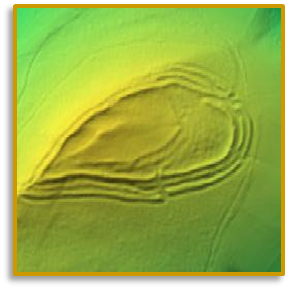
It is a spider but showing 0.0000 probability .
What’s wrong with the model?
I am not sure about the exact problem but is spider the first value in your list of source images i.e the part just before for loop where you make a list of sources to get images of?
I think the 0th item is something else.
Hi everyone,
I am glad to share the work I have done for the first lesson of this course. I decided to have a look to spoken digits dataset and see if I can use some computer vision to classify the data. All the useful links are in the notebook I created to do this experiment.
Please feel free to reach me if you have any question or suggestion!
Try…
prediction, index, probs = learn........
probs[index]
Hello everyone,
I made a simple bicycle classification among the following three categories
- Road Bike
- Mountain Bike
- BMX
Hosted the app on HuggingFace spaces Bike Classification - a Hugging Face Space by anubhavmaity
You can find the training files, models, training notebooks and app.py file in this link anubhavmaity/bike-classification at main
A book reviews generator, that was trained on the Amazon Books Reviews Dataset | Kaggle.
It does a decent job ![]()
Up next - adding an option to submit the book title for better results.
Hello everyone. I am happy to share my bear detector app which has now been deployed successfully on Hugging Face Huggy Bear - a Hugging Face Space by Stephen137
The notebook used to create the model can be found here: Huggy Bear | Kaggle
I tried initially to replicate Jeremy’s nifty NoteBook to app.py conversion but got error message No module named ‘gradio’.
Would be awesome if anyone has a fix for this? I had to accept defeat and ended up just copying and pasting the required text for the app.py file.
Oh, one thing I found was that the Hugging Face environment needs a ‘requirements.txt’ file in order to recognise the fastai library. You need to create a file with the following text included: fastai<=2.0.0
You can see the content of my app.py file and ‘requirements.txt’ within the ‘Files and versions’ tab.
One other major problem I’m having as I go along, is that after downloading and viewing an image (and including some commentary on it), when I run the NoteBook again, a different image is grabbed, and so my narrative is not relevant any more! Is there any way to ‘lock’ the initial image? Any tips on this would be much appreciated. Sorry if I’m missing something obvious!
Thanks
Based on lesson 1 & 2 and chapter 1&2 from the book, I am able to create a pneumonia detector from chest X-Ray images with over 95% accuracy with huggingspace and gradio. To do that I used popular dataset on kaggle.com called Chest X-Ray images (Pneumonia), and trained using resnet50. I am starting to enjoy the process.
You can check out here: Pneumonia - a Hugging Face Space by murodbek
There is no gradio package mentioned in the requirements.txt
Clean air project: Here is my Week 1 project.
We all saw these kinds of images during covid:
Can we use deep learning to detect if the air is clean? Better yet, can we tell the AQI through an image of a skyline?
Installing and maintaining expensive AQI sensors in developing countries would not be financially feasible. And, these are the countries that are most affected by the harmful effects of air pollution.
Ideally, I would like to build a regression model that can predict AQI. The current model just classifies between clean vs. polluted air skyline.
I also created a Gradio app thanks to @suvash and @ilovescience’s nice tutorial!
Would love everyone’s feedback! Also, some pointers on how to build a model that can predict AQI.
Folks, here’s a beginner friendly computer vision project, a shoes classifier ![]()
![]() Use Kaggle dataset
Use Kaggle dataset
![]() Run basic training experiments
Run basic training experiments
![]() Evaluate model → looks good
Evaluate model → looks good
![]() Download completely new data for a test set
Download completely new data for a test set
![]() Evaluate model on test set
Evaluate model on test set
![]() The model seems to pretty much just work! (and to generalize quite good)
The model seems to pretty much just work! (and to generalize quite good)
Code, links and a write-up of some thoughts can be found on this repo here
Looks fantastic! I was wondering what platform are you planning to use for blogging. Would love to see it.
